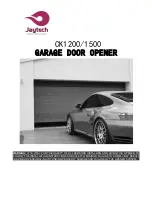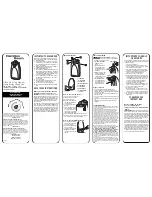
Horizontal tracks
Door edges
3/4” To 7/8”
3/4” To 7/8”
Attaching Weather Seal
24
Permanently attach the weatherstrips on both door jambs and header. The weatherstrips
were temporarily attached in Preparing the Opening, in the pre-installation section of this
manual.
NOTE:
When permanently attaching the weatherstrips to the jambs, avoid pushing the weath-
erstrips too tightly against the face of door.
Weather seals
Nail
Weather
seal
Jamb
Weather seal
installed
Jamb
Header
Jamb
Nail
NOTE:
Door not shown for clarity.
Balancing Door
25
Remove locking pliers. Lift door and check its balance. Adjustments to the required number
of spring turns stated may be necessary. If door rises off floor more than 2 ft. under spring
tension alone, reduce spring tension. If the door is hard to rise or drifts down on its own, add
spring tension. A poorly balanced door can cause garage door operator problems.
To adjust spring tension, fully close door. Apply locking pliers to track above third track roller.
Place locking pliers on torsion shaft, as shown in Step Attaching Counterbalance Lift Cables.
Insert a winding rod into the winding cone. Push upward on the winding rod slightly while
carefully loosening the set screws in the winding cone.
IMPORTANT:
BE PREPARED TO SUPPORT THE FULL FORCE OF THE TORSION SPRING ONCE
THE SET SCREWS ARE LOOSE.
Carefully adjust spring tension 1/4 turn. Retighten both set screws to 14-15 ft. lbs. of torque
in the winding cone and repeat for the other side. Recheck door balance and re-adjust spring
tension if needed.
IMPORTANT:
DO NOT ADJUST MORE THAN 1 TURN FROM THE RECOMMENDED NUMBER
OF TURNS.
If the door still does not operate easily, lower the door into the closed position, unwind
spring(s) completely, and recheck the following items:
1.) Is the door level?
2.) Are the torsion shaft and flag angles / angle mount level and plumb?
3.) Does the distance between the flag angles / angle mount equal door width plus 3-3/8” to
3-1/2”?
4.) Do the counterbalance lift cables have equal tension? Adjust if necessary.
5.) Rewind the spring(s).
6.) Make sure door is not rubbing on jambs.
IMPORTANT:
IF DOOR STILL DOES NOT BALANCE PROPERLY, THEN CONTACT A TRAINED
DOOR SYSTEM TECHNICIAN.
MAINTENANCE
Cleaning Your Garage Door
IMPORTANT:
DO NOT USE A PRESSURE WASHER ON YOUR GARAGE DOOR!
While factory-applied finishes on garage doors are durable, it is desirable to clean them on
a routine basis. Some discoloration of the finish may occur when a door has been exposed
to dirt-laden atmosphere for a period of time. Slight chalking may also occur as a result of
direct exposure to sunlight. Cleaning the door will generally restore the appearance of the
finish. To maintain an aesthetically pleasing finish of the garage door, a periodic washing of
the garage door is recommended.
THE FOLLOWING CLEANING SOLUTION IS RECOMMENDED:
A mild detergent solution
consisting of one cup detergent (with less than 0.5% phosphate) dissolved into five gallons of
warm water will aid in the removal of most dirt.
NOTE:
The use of detergents containing greater than 0.5% phosphate is not recommended
for use in general cleaning of garage doors.
NOTE:
Be sure to clean behind weatherstrips on both sides and top of door.
CAUTION
NEVER MIX CLEANSERS OR DETERGENTS WITH BLEACH.
NOTE:
Do not use any window cleaning fluids, scouring compounds, gritty cloths or solvent-
based cleaners of any kind.
To clean polycarbonate windows, see
www.Wayne-Dalton.com
.
Painting Your Garage Door
Refer to Instruction Insert “
Field Painting and Finishing Fiberglass or Steel Door Sec-
tions
”.
Maintaining The Finish On
Your Garage Door
If the factory finish is beginning to fade, the door may require a field applied top clear coat.
Depending on environment and usage, this may be necessary after 1 to 3 years of use. Refer
to Instruction Insert “
Field Painting and Finishing Fiberglass Or Steel Door Sections
”.
Operation And Maintenance
OPERATING YOUR GARAGE DOOR:
Before you begin, read all warning labels affixed to
the door and the installation instructions and owner’s manual. When correctly installed, your
Wayne Dalton door will operate smoothly. Always operate your door with controlled move-
ments. Do not slam your door or throw your door into the open position, this may cause dam-
age to the door or its components. If your door has an electric opener, refer to the owner’s
manual to disconnect the opener before performing manual door operation below.
MANUAL DOOR OPERATION:
For additional information on manual garage door operations
go to
www.dasma.com
and reference TDS 165.
WARNING
DO NOT PLACE FINGERS OR HANDS INTO SECTION JOINTS WHEN
OPENING AND/OR CLOSING A DOOR. ALWAYS USE LIFT HANDLES /
SUITABLE GRIPPING POINTS WHEN OPERATING THE DOOR MANUALLY.
OPENING A DOOR:
Make sure the lock(s) are in the unlocked position. Lift the door by using
the lift handles / suitable gripping points only. Door should open with little resistance.
CLOSING A DOOR:
From inside the garage, pull door downward using lift handles / gripping
point only. If you are unable to reach the lift handles/ suitable gripping points only, use pull
down rope affixed to the side of door. Door should close completely with little resistance.
USING AN ELECTRIC OPERATOR:
IMPORTANT:
PULL DOWN ROPES MUST BE REMOVED AND LOCKS MUST BE REMOVED OR
MADE INOPERATIVE IN THE UNLOCKED POSITION.
When connecting a drawbar (trolley type) garage door operator to this door, a drawbar opera-
tor bracket must be securely attached to the top section of the door, along with any struts
provided with the door. Always use the drawbar operator bracket supplied with the door. To
avoid possible damage to your door, Wayne Dalton recommends reinforcing the top section
with a strut (may or may not be supplied). The installation of the drawbar operator must be
11
































